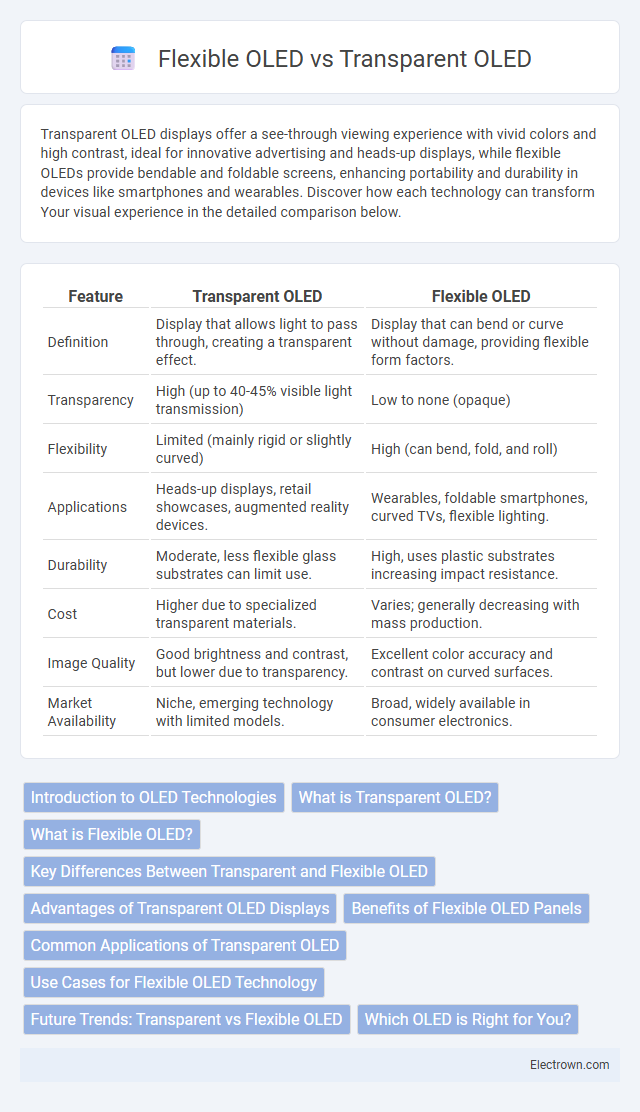Transparent OLED displays offer a see-through viewing experience with vivid colors and high contrast, ideal for innovative advertising and heads-up displays, while flexible OLEDs provide bendable and foldable screens, enhancing portability and durability in devices like smartphones and wearables. Discover how each technology can transform Your visual experience in the detailed comparison below.
Table of Comparison
| Feature | Transparent OLED | Flexible OLED |
|---|---|---|
| Definition | Display that allows light to pass through, creating a transparent effect. | Display that can bend or curve without damage, providing flexible form factors. |
| Transparency | High (up to 40-45% visible light transmission) | Low to none (opaque) |
| Flexibility | Limited (mainly rigid or slightly curved) | High (can bend, fold, and roll) |
| Applications | Heads-up displays, retail showcases, augmented reality devices. | Wearables, foldable smartphones, curved TVs, flexible lighting. |
| Durability | Moderate, less flexible glass substrates can limit use. | High, uses plastic substrates increasing impact resistance. |
| Cost | Higher due to specialized transparent materials. | Varies; generally decreasing with mass production. |
| Image Quality | Good brightness and contrast, but lower due to transparency. | Excellent color accuracy and contrast on curved surfaces. |
| Market Availability | Niche, emerging technology with limited models. | Broad, widely available in consumer electronics. |
Introduction to OLED Technologies
Transparent OLED displays offer innovative visual experiences with their ability to become see-through while still delivering vibrant colors and sharp images, making them ideal for applications like augmented reality and heads-up displays. Flexible OLED technology, on the other hand, provides durability and versatility by enabling bendable and foldable screens that maintain high resolution and brightness, popular in devices such as foldable smartphones and wearable gadgets. Both Transparent and Flexible OLEDs utilize organic compounds that emit light efficiently without backlighting, emphasizing energy efficiency and design adaptability in modern display technologies.
What is Transparent OLED?
Transparent OLED is a display technology that integrates organic light-emitting diodes on a transparent substrate, allowing screens to show images while maintaining see-through properties. Unlike traditional displays, Transparent OLED panels enable users to view content without obstructing the background, making them ideal for augmented reality, retail showcases, and automotive applications. This technology leverages transparent electrodes and special organic materials to achieve high transparency rates above 40%, balancing vivid visuals with see-through clarity.
What is Flexible OLED?
Flexible OLED is a type of organic light-emitting diode display that uses pliable substrates, enabling screens to bend, fold, or roll without damage. This technology employs thin, lightweight materials such as plastic instead of conventional glass, enhancing durability and design versatility in devices like smartphones, wearables, and foldable tablets. Flexible OLEDs provide high contrast ratios, vibrant colors, and energy efficiency while supporting innovative form factors that improve user experience and device portability.
Key Differences Between Transparent and Flexible OLED
Transparent OLED displays provide clear visuals by allowing light to pass through the screen, enabling see-through viewing experiences ideal for augmented reality and retail displays. Flexible OLEDs feature bendable substrates made from materials like plastic, offering durability and design versatility for curved or foldable devices. Key differences include transparency levels, with Transparent OLEDs emphasizing light transmission, while Flexible OLEDs prioritize mechanical flexibility and shape adaptability.
Advantages of Transparent OLED Displays
Transparent OLED displays offer superior visual clarity and vibrant color reproduction with the ability to seamlessly blend digital content into real-world environments. These displays enable innovative applications in retail, automotive heads-up displays, and augmented reality by providing see-through viewing experiences without compromising brightness or contrast. Their lightweight and energy-efficient design enhances device portability and sustainability compared to traditional display technologies.
Benefits of Flexible OLED Panels
Flexible OLED panels offer superior durability and versatility compared to Transparent OLED, allowing for curved, foldable, and rollable displays that enhance user experience and device functionality. Their lightweight and thin design provides greater portability while maintaining high resolution and vibrant color accuracy. You can enjoy innovative applications in smartphones, wearables, and automotive displays due to the adaptability of Flexible OLED technology.
Common Applications of Transparent OLED
Transparent OLED technology is commonly applied in advanced retail displays, allowing products to remain visible through the screen while showcasing dynamic digital content. It is also widely used in automotive heads-up displays (HUDs) to provide crucial driving information without obstructing the driver's view. Architectural glass and smart windows incorporate transparent OLEDs to enhance building aesthetics and functionality with embedded visual features.
Use Cases for Flexible OLED Technology
Flexible OLED technology is widely used in applications requiring bendable or foldable displays, such as foldable smartphones, wearable devices, and curved televisions, enhancing portability and user experience. Its ability to conform to various shapes makes it ideal for automotive dashboards and innovative signage solutions where space and design flexibility are crucial. You can expect flexible OLEDs to drive advancements in compact electronics and immersive display technologies.
Future Trends: Transparent vs Flexible OLED
Transparent OLED technology is anticipated to revolutionize augmented reality displays and smart windows with its ability to integrate seamless digital content into real-world environments. Flexible OLEDs will dominate wearable devices and foldable smartphones, offering enhanced durability and immersive viewing experiences through bendable screens. You can expect both technologies to complement each other as the future of display innovation prioritizes flexibility and transparency to meet versatile consumer demands.
Which OLED is Right for You?
Transparent OLED displays offer a futuristic visual experience with clear, see-through screens ideal for retail showcases, heads-up displays, and smart windows, emphasizing design integration and aesthetic appeal. Flexible OLED panels provide durability and bendability, making them perfect for wearable devices, foldable smartphones, and curved screens where adaptability and portability are priorities. Choosing between Transparent OLED and Flexible OLED depends on whether you prioritize visual transparency and design (Transparent OLED) or device flexibility and resilience (Flexible OLED).
Transparent OLED vs Flexible OLED Infographic

 electrown.com
electrown.com